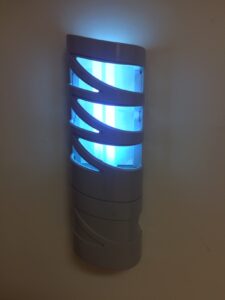Flies that generally invade from outdoors – house flies and blow flies – respond strongly to light, but those that breed inside – moth flies and phorid flies – will not be very attracted to Insect Light Traps. Placement of an insect light trap will not have great benefit for infestations involving these small flies.
Once entering a building, flies take a while to become adjusted to interior lighting and thus responsive to the light wavelengths given off by an insect light trap. A period of 15 minutes to hours may elapse before a particular fly becomes attracted to an insect light trap. In addition, a fly may need to be within 25 feet of a trap to see it.
Follow these dos and don’ts when installing insect light traps.
DO
- Use wall-mounted units low to the floor, 3-6 feet, for daytime flying insects. The bulbs should be 4-5 feet from the door.
- Use ceiling-mounted units placed 8-10 feet from the floor for night-time flying insects when the ceiling is higher than 10 feet.
- Additionally, it is important to change the UV bulbs at least once per year. Installing fresh bulbs during the spring ensures the highest performance during peak fly season.
- Position insect light traps between the attracting source and production areas.
- Keep wall mounted units at least 5 feet from food-production areas. (3 feet for insect light traps that use a glue board)
- Place light traps in dark areas and hallways.
- Focus traps at “bottlenecks” or funnel areas (more flies in smaller areas).
- If a facility has an interior or partially enclosed trash collection dumpster, installation of a trap next to or over the dumpster will catch many, if not most, of the flies attracted to the area. Be sure to install the trap so that is does not face outside areas.
- Adding odor attractants to light traps improve the long-term results.
DON’T
- Placing the trap too high above the floor (higher than 6 feet).
- Locating the trap too close to doorways. Flies fly past the traps before they actually see it.
- Mount units where natural light from outside can compete with the light from the insect light trap.
- Mount inside where high intensity mercury vapor lights are installed.
- Use ceiling-mounted units in food-processing areas. There is a possibility of the contents being blown out if the glue boards dry out before being replaced.
- Place where light from the insect light trap can be seen from the outside. Only very high wattage (100 watts or more) bulbs can attract from a large distance. Flies that are outside are surrounded by daylight. Try to prevent any unit from being seen from outside.
- Rely solely on light traps for a control program. They are only one tool in an integrated program.
- Install in areas where they are likely to be hit by machinery, such as a forklift.
- Install light traps near extreme heat or cold, or in areas where air currents are particularly strong.
- Install a light trap at ceiling level, directly over, or next to a food preparation surface. This may attract more flies and other flying insects to the food than would ordinarily be attracted by the food itself. These insects could then possibly get into the food as it’s prepared. Light traps are better placed where they would attract insects away from these surfaces.
- Place too few traps. Insect light traps need to be spaced throughout a facility following the natural flight path flies might take as they move through the building. Establish traps to intercept flies.
Poulin’s Pest Control sells many options for insect light traps. Call our retail store directly to find out more information on light traps and where/how to place them for effective fly control.

